by Moab Museum Staff
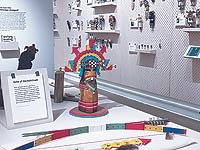 |
| An interactive table at the Moab Museum allows visitors hands-on opportunities to engage with katsintithu and gifts of Katsinam. |
This winter, the Moab Museum has come alive with color. A wide array of intricately carved and vibrantly painted katsintithu – widely known as “kachina dolls”– are on exhibit through February 2022. The temporary exhibition entitled Hopi Katsina: Evolving Styles, Enduring Meanings, offers a glimpse into the flourishing cultural and creative tradition of Hopi katsintithu carving, a practice closely linked to long held traditions for Hopi people. Carving demonstrations provide visitors the opportunity to learn firsthand from carvers and experience the creative process as it unfolds.
Visitors to and residents of the Southwest may recognize “kachina dolls” from gift shops and galleries across the region. To non-Natives, these carvings are widely recognized as beautiful and are often collected by art lovers. To Hopi people, Katsina is a way of life, and the carvings hold meanings related to Katsina spirits that visit Hopi people. Katsintithu are used ceremonially, and also serve to educate children about Hopi beliefs and culture. The tradition of katsintithu carving dates to the 18th century, and carvers began creating them specifically for market around the late 19th or early 20th century.
The exhibit features dozens of katsintithu from numerous contemporary Hopi carvers of all ages. Visitors to the Museum are able to view both contemporary and traditional katsintithu,
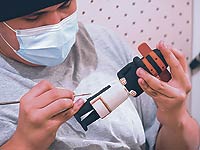 |
| Carver Hongvi Marquez adds fine details to a katsintihu during a carving demonstration in October. (Photo: Nathaniel Clark) |
and see how different carvers depict the same Katsina spirit in their own unique ways. The exhibition explores how katsintithu are used in ceremony and in Hopi families, and also traces stylistic changes in carving and painting styles through time. Most of the contemporary katsintithu on exhibit have been loaned to the Museum by Moab resident Thom Moreau, and many also come from the collection of the Kopell Family.
In October and November, the Museum welcomed carvers Hongvi Marquez and Adam Suetopka for demonstrations of carving. Each carver spent two days sharing insights into the creative process and cultural tradition in the Museum gallery, offering audiences the opportunity to experience firsthand the process of transforming a piece of paako (cottonwood root) into a colorful carving.
The process begins with shaping the soft, lightweight cottonwood root with blades and files. Once the desired shape has been achieved and a basecoat is applied, it is time to paint. Both Marquez and Suetopka make their pigments themselves, seeking out colorful pigments in the rocks around the Hopi Mesas in Arizona to mix into vibrant paints. Lastly, tied feathers and other ornamentation are attached to the figure. Visitors to the Museum were able to experience this process unfolding, and had the opportunity to talk with Marquez and Suetopka about their work.
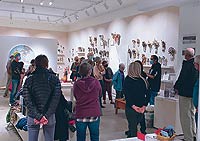 |
| A crowd gathers to hear from carver Adam Suetopka on November 13, 2021. |
The Moab Museum is honored to welcome a third carver, Shawn Deel, on Friday and Saturday, December 10 and 11. Described as stylistically “groundbreaking,” Deel’s work fuses tradition with innovation. Visitors can expect to watch the entire process unfold and learn firsthand about how Shawn’s work blends tradition and new ideas. For more information about the upcoming demonstration, the exhibit, and Katsina tradition, visit moabmuseum.org.
The Museum is open Tuesday through Saturday, 10 a.m. to 6 p.m. Consider becoming a member. When you join the Moab Museum at any membership level, you directly support the preservation of the region’s cultural and natural history. Members empower the Moab Museum to grow, inspire, and serve the community now and for future generations. Business memberships are also available.
www.moabmuseum.org • 118 East Center Street, Moab, UT • 435-259-7985
118 East Center Street, Moab — 435-259-7985 — moabmuseum.org
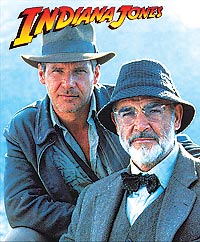 Red Cliffs Lodge, on the banks of the mighty Colorado River, is home to the Moab Museum of Film & Western Heritage. The lodge is built on the old George White Ranch, a key location for nine of the big westerns including Rio Grande, Cheyenne Autumn, Ten Who Dared, The Commancheros, and Rio Conchos.
Red Cliffs Lodge, on the banks of the mighty Colorado River, is home to the Moab Museum of Film & Western Heritage. The lodge is built on the old George White Ranch, a key location for nine of the big westerns including Rio Grande, Cheyenne Autumn, Ten Who Dared, The Commancheros, and Rio Conchos.
The late George White was founder of the Moab to Monument Valley Film Commission, the longest ongoing film commission in the world.
In the museum one can learn more about film locations, how the sets are built, and how the filming process is managed on nature’s own sound stage. On display in the museum are production photographs, movie posters, autographed scripts, props from the many pictures filmed in the area, and displays about the western ranching heritage. For information, call Red Cliffs Lodge at 435-259-2002.
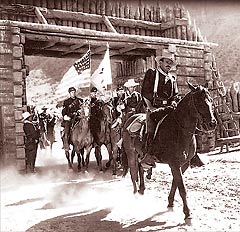 Through the magnificent landscapes of southeastern Utah, writers have been inspired and stories born here. Zane Grey, the famous western novelist, traveled through the area in 1912. His visit inspired him to write his book Riders of the Purple Sage. The book was made into a movie starring Ed Harris and Amy Madigan, and filmed on locations around Moab.
Through the magnificent landscapes of southeastern Utah, writers have been inspired and stories born here. Zane Grey, the famous western novelist, traveled through the area in 1912. His visit inspired him to write his book Riders of the Purple Sage. The book was made into a movie starring Ed Harris and Amy Madigan, and filmed on locations around Moab.
| A partial list of stars that have made movies in Moab John Wayne, Maureen O'Hara, Henry Fonda, Lee Marvin, Rock Hudson, Jimmy Stewart, Richard Boone, Anthony Quinn, Mickey Rooney, Shirley Temple, Kris Kristofferson, Billy Crystal, Robert Duvall, Gene Hackman, Bill Murray, Jack Palance, Susan Sarandon, Geena Davis, Ted Danson, Tom Cruise, and many more. |